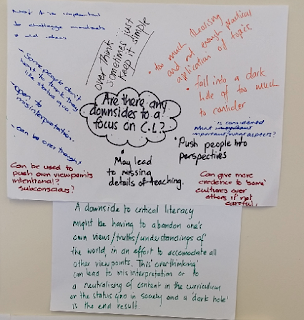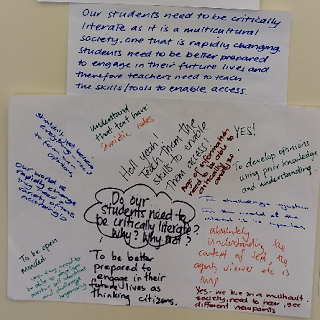Multimulti everything -
- Multi media,
- Multi culturalism,
- Multi disciplines,
- Multi literacies
- Professor Steven May - Making multi cultural education work
- Brian Bulevant - the pluralist theory
- Elwyn Richardson - the song of the bird
- Sylvia Ashton-Warner - Grounded theory in literacy development
- Murial Simpson - championed the first ready to read system
- Barbara Comber
- Pualo Freire - Social justice
- Clarke & Whitney - Deconstructing, Reconstructing text
- Michael Haliday - Linguist
- Delpit (1988) - The Culture of power
- James Paul Gee - big D discourse and little D discourse. Discourse is bigger than the language but a way of being. Little D is the everyday language.
- Jim Cummings - BICS and CALPS
- Helen Timperley - Adaptive expertise through continuous inquiry and being able to adapt practice to meet the needs of students.
Elwyn Richardson – Song of the bird. Example of “Do it, Say it, Write it, Read it.”
Radical Change Texts:
- Researchers - Eliza Dresang and Sylvia Panteleo
- Accessibility, connectivity and interactivity - books that compete with digital text and push boundaries of sensitive subjects (death, childbirth, decency…)
- Be careful and clever about who the text is chosen for…
 Authors of RCTs - Shaun Tan, John Marsden, Emily Gravett, David Wiesner, Herve Tullet (Press), Istvan Banyai (Zoom), Jenny Baker (WIndow, Belonging)Emily Gravett – Wolves. Pre lesson: Factual Hand/Literary Hand (Great inter-text book)Wolves change rivers (You tube video) links well to this book.Follow up with ‘The Wolf Story’Wolves by Emily Gravett - breaking it up by introducing the cover, making predictions, making connections with what we knew about wolves, making connections between texts etc...Gradual Release Model: To - With - By (Balanced Literacy Programme)
Authors of RCTs - Shaun Tan, John Marsden, Emily Gravett, David Wiesner, Herve Tullet (Press), Istvan Banyai (Zoom), Jenny Baker (WIndow, Belonging)Emily Gravett – Wolves. Pre lesson: Factual Hand/Literary Hand (Great inter-text book)Wolves change rivers (You tube video) links well to this book.Follow up with ‘The Wolf Story’Wolves by Emily Gravett - breaking it up by introducing the cover, making predictions, making connections with what we knew about wolves, making connections between texts etc...Gradual Release Model: To - With - By (Balanced Literacy Programme)
- Between paired reading and inquiry there should be SSR
- At the beginning point the student will be totally reliant on the teacher...at the end point student will have full independence.
- Modelled writing is based on ‘Think alouds’.
- Guided reading and Guided Writing is the heart of the Model (Zone of proximity)
- Everyday in everyway there should be a balance of oral, written and visual.
- Fine balance between levels of activity and passivity
- Aesthetic opportunities should be available on a daily basis - Sir Ken Robertson
- Multimodal - aural, visual, spatial, gestural, written, kinesthetic, LinguisticTowards the end of the semester, we were facilitated through a bus stop activity where we had a minute to write out thoughts about questions posed on A3 papers, passed around the tables...These are in no particular order:
ARE THERE ANY DOWNSIDES TO A FOCUS ON CRITICAL LITERACY?
HOW DO PEOPLE'S IDEOLOGIES IMPACT ON US?
HOW WOULD YOU DEFINE CRITICAL LITERACY?
WHAT IS THE DIFFERENCE BETWEEN CRITICAL LITERACY AND CRITICAL THINKING?
DOES IDENTITY COUNT? IS THIS CRITICAL LITERACY? WHY?
IS THERE A LINK BETWEEN CRITICAL LITERACY AND NATIONHOOD? HOW SO?
WHAT IS YOUR UNDERSTANDING OF HEGEMONY?
DO OUR STUDENTS NEED TO BE CRITICALLY LITERATE? WHY? WHY NOT?
WHY MIGHT YOUR COLLEAGUES THINK CRITICAL LITERACY IS NOT IMPORTANT?
HOW MIGHT CRITICAL LITERACY LOOK IN YOUR OWN PROFESSIONAL CONTEXT?
WHY IS CRITICAL LITERACY IMPORTANT?So, that is some of the learning I received this semester in Critical Literacy...and when I look at the brief above, this only scrapes the surface. I was fortunate enough to be in a small class with 10 other wonderful women from across the educational spectrum, I learnt as much from them as I did from the lecturer.If I could do it all again, I would in a heart beat!!!...so much to learn in so little time.














No comments:
Post a Comment